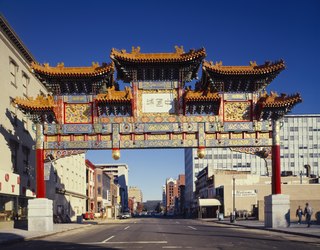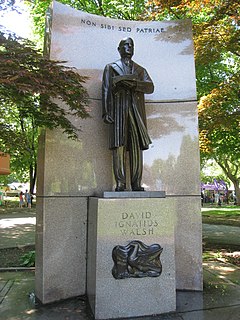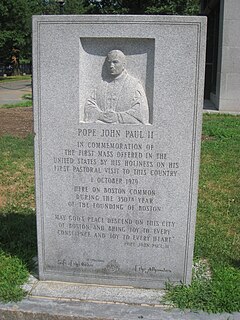
American Chinese cuisine is a style of Chinese cuisine developed by Chinese Americans. The dishes served in many North American Chinese restaurants are adapted to American tastes and often differ significantly from those found in China.

A Chinatown is an ethnic enclave of Chinese people located outside mainland China, Hong Kong, Macau or Taiwan, most often in an urban setting. Areas known as "Chinatown" exist throughout the world, including Europe, North America, South America, Asia, Africa and Australasia.

A paifang, also known as a pailou, is a traditional style of Chinese architectural arch or gateway structure. Evolved from the Indian subcontinent's torana through the introduction of Buddhism to China, it has developed many styles and has been introduced to other East Asian countries, such as Korea, Japan, and Vietnam.

Chinatown, Boston is a neighborhood located in downtown Boston, Massachusetts. It is the only surviving historic ethnic Chinese enclave in New England since the demise of the Chinatowns in Providence, Rhode Island and Portland, Maine after the 1950s. Because of the high population of Asians and Asian Americans living in this area of Boston, there is an abundance of Chinese and Vietnamese restaurants located in Chinatown. It is one of the most densely populated residential areas in Boston and serves as the largest center of its East Asian and Southeast Asian cultural life. Chinatown borders the Boston Common, Downtown Crossing, the Washington Street Theatre District, Bay Village, the South End, and the Southeast Expressway/Massachusetts Turnpike. Boston's Chinatown is one of the largest Chinatowns outside of New York City.

The New York metropolitan area is home to the largest and most prominent ethnic Chinese population outside of Asia, hosting Chinese populations representing all 34 provincial-level administrative units of China. The Chinese American population of the New York City metropolitan area was an estimated 893,697 as of 2017. New York City itself contains by far the highest ethnic Chinese population of any individual city outside Asia, estimated at 628,763 as of 2017.

There are multiple Chinatowns in the borough of Queens in New York City. The original Queens Chinatown emerged in Flushing, initially as a satellite of the original Manhattan Chinatown, before evolving its own identity, surpassing in scale the original Manhattan Chinatown, and subsequently, in turn, spawning its own satellite Chinatowns in Elmhurst, Corona, and eastern Queens.

Driver's Seat is a 1994 galvanized steel sculpture by Don Merkt, installed along the Transit Mall in Portland, Oregon's Old Town Chinatown neighborhood, in the United States. The artwork was funded by the City of Portland's Percent for Art program, the Portland Development Commission, and TriMet, and remains part of the City of Portland and Multnomah County Public Art Collection courtesy of the Regional Arts & Culture Council.

Ventana al Pacifico is an outdoor 1989 marble sculpture by Manuel Neri, located outside of the Gus J. Solomon United States Courthouse in downtown Portland, Oregon.

Chinatown Gateway is an outdoor paifang and sculpture which serves as an entrance to Portland, Oregon's Old Town Chinatown neighborhood, in the United States. The gate was proposed by the Chinese Consolidated Benevolent Association in 1984. Architect Yu Tang Wang and artist Sun Chau completed the gate's design, which was built by Ting Hwa Architects in Taiwan. It was then shipped to Portland and installed in one week before being dedicated in November 1986. It cost $256,000 and was the largest of its kind in the United States until one in Washington, D.C. was completed several months later.

The Dragon Gate is a south-facing gate at the intersection of Bush Street and Grant Avenue, marking a southern entrance to San Francisco's Chinatown, in the U.S. state of California. Built in 1969 as a gift from the Republic of China (Taiwan) in the style of a traditional Chinese pailou, it became one of the most photographed locations in Chinatown, along with the older Sing Fat and Sing Chong buildings.

Friendship Archway is a paifang installed at Chinatown, Washington, D.C., United States. It is one of the largest ceremonial arches outside of China.

Pearl River Mart is an Asian-American retail brand and family-run business in New York City. The business was founded in 1971 in Chinatown, Manhattan, as Chinese Native Products by Ming Yi Chen and a group of student activists from China, Hong Kong, and Taiwan. Chen has said that she and her colleagues "wanted to create a small window into the Chinese culture". Its products include braided straw slippers, paper lanterns, cheongsams, cotton Mary Janes, and copies of Mao's Little Red Book. Pearl River Mart has become a New York City institution. The business has an art gallery in its main location, and hosts in-store events and performances.

The Boston Massacre Monument, also known as the Crispus Attucks Monument and Victory, is an outdoor bronze memorial by Adolph Robert Kraus, installed in Boston Common, in Boston, Massachusetts, United States.

An equestrian statue of Joseph Hooker is installed outside the Massachusetts State House, facing Beacon Street in Boston, in the United States.

A statue of Tadeusz Kościuszko by Theo Alice Ruggles Kitson is installed in Boston's Public Garden, in the U.S. state of Massachusetts.
Echo of the Waves is a sculpture by Susumu Shingu, installed outside the New England Aquarium, in Boston, Massachusetts, United States. It was completed in September 1981, and dedicated on July 6, 1983. The abstract, kinetic structure is made of painted steel and Teflon coated fiberglass, and rests on a painted steel base. It was surveyed as part of the Smithsonian Institution's "Save Outdoor Sculpture!" program in 1994.

The World War II Memorial by John Francis Paramino is installed in Boston, Massachusetts, United States. It was completed during 1947–1949, copyrighted in 1948, and erected in 1949. The bronze and granite war memorial features an allegorical statue of winged female figure of Victory. Behind her is a wall with 27 bronze plaques listing the names of people who died in World War II. The work was surveyed as part of the Smithsonian Institution's "Save Outdoor Sculpture!" program in 1993.

A statue of Benjamin Franklin by Richard Saltonstall Greenough is installed outside Old City Hall in Boston, Massachusetts, United States. It rests on a base with plaques designed by Greenough and Thomas Ball.

A statue of David I. Walsh by Joseph Coletti is installed along Boston's Charles River Esplanade, in the U.S. state of Massachusetts.

A memorial placard of Pope John Paul II, sometimes called Papal Mass Plaque, is installed in Boston Common in Boston, Massachusetts, United States.























